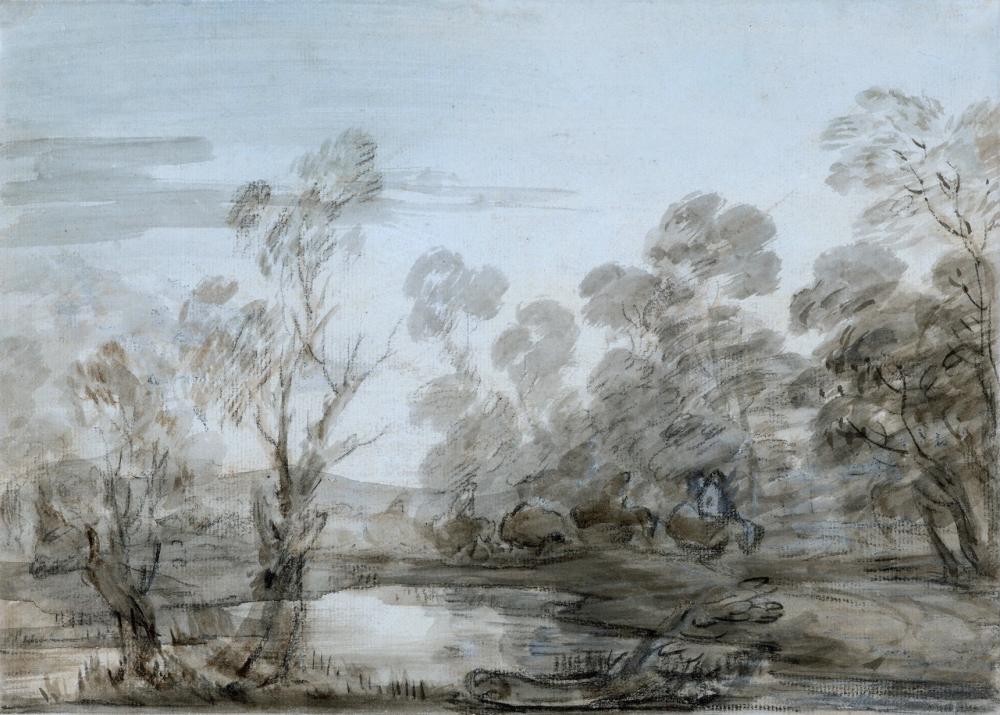THOMAS GAINSBOROUGH R.A.
(1727-1788)
Open Landscape with Drover and Packhorses
Provenance
Hon. Mrs M Maude, January 1871
Alice Emily Maude
Viscount Hawarden, Wingham Court
Private Collection
Literature
John Hayes, The Drawings of Thomas Gainsborough, 2 vols, London 1970, pp. 172–73, no. 275.
A number of drawings bear a gold stamp of the artist’s initials or his full name and it has been assumed that he considered these sheets as finished works of art and gave them away as gifts. (He is reported as never selling a drawing). These sheets show an assurance and finish that provide the bedrock of his reputation as one of the most accomplished draughtsman of the eighteenth century. The drawing has two outstanding qualities. Compositionally it is ambitious and perfectly balanced and the artist uses with consummate skill the brown paper as a tone in the composition.
The drawing shows two packhorses with empty wooden saddles standing and lying beside an ancient pollarded oak tree with their handler, a young lad, contemplatively leaning against the hollow trunk of the tree. As carts were inefficient in the hilly terrain around Bath, packhorses with wooden saddles were used to transport goods around the area and they appear in several drawings that date from the early 1760s. Similarly the ancient oak, with its connection to provide timber for the British navy had become a symbol of English power, and, as in so many of the artist’s other landscape paintings and drawings, it brings an element of nostalgia into the composition. Despite the lack of foliage it serves as a familiar landmark for both drover and horses, sheltering the figures and dramatically dividing the composition. The tree, pollarded and hollow, shows that it had fulfilled this role for many years and that it had received the attention of woodsmen for many generations.
Perhaps frustrated by the limited amount of time he had available to paint landscapes, Gainsborough made a number of watercolours in the early 1760s and the drawing, the subject of this note, marks a sophisticated development from these sheets. Using blocks of bodycolour and dappled strokes on the tree trunk above the horse’s back and on the standing horse’s rump, he varies the qualities of the tone and creates varied forms and textures. The areas that he has left blank rely for their effect on the brown colour of the paper and the grey wash lines for the detail. This effect anticipates the rich combination of coloured washes, bodycolour and chalk that he used in his drawings later in the decade which were to compete with oil paintings in exhibitions at the Royal Academy.
There are a number of drawings that Gainsborough produced in the mid-1760s that use this upright format most of them use the space to show tree-lined lanes with high banks, unusually this shows a hill top. This design is amongst Gainsborough’s most subtle using the angled tree as a visual fulcrum between the distant brilliant white cloud and the two tired horses in the foreground.
Hugh Belsey
NOTES
1. Susan Sloman noted this feature in the landscape formerly at Holloway College and she illustrates a small drawing of a horse with a wooden saddle (S. Sloman, ‘The Holloway Gainsborough: its subject re-examined’, Gainsborough’s House Review, 1997/98, pp. 47–54). Another drawing has appeared since her article, see H. Belsey, ‘A Second Supplement to John Hayes’s The Drawings of Thomas Gainsborough’, Master Drawings, XLVI, Winter 2008, p. 532, no. 1118, fig. 139.
2. For an examination of the pollarded tree in eighteenth-century painting, see E. L. Smith, ‘“The aged pollard’s shade”: Gainsborough’s Landscape with Woodcutter and Milkmaid’, Eighteenth-Century Studies, XLI (1), Autumn 2007, pp. 17–39.
3. The latest review of this technique, described in a letter to the artist’s friend William Jackson, is by L. H. Paisley and M. Broadway in Landsape Innovation and Nostalgia: The Manton Collection of British Art, edited by J. A. Clarke, New Haven and London 2012, pp. 103–9.
4. See John Hayes, The Drawings of Thomas Gainsborough, London 1970, pp. 172–73, nos. 274, 276, 278, pls. 87, 88 and Belsey, op. cit. 2008, pp. 488–89, no. 1044,
fig.69


